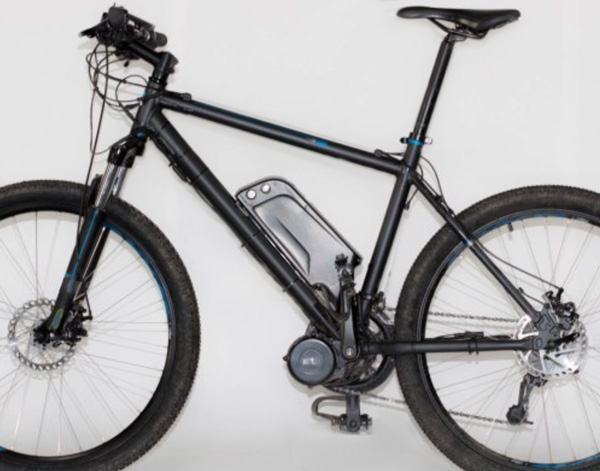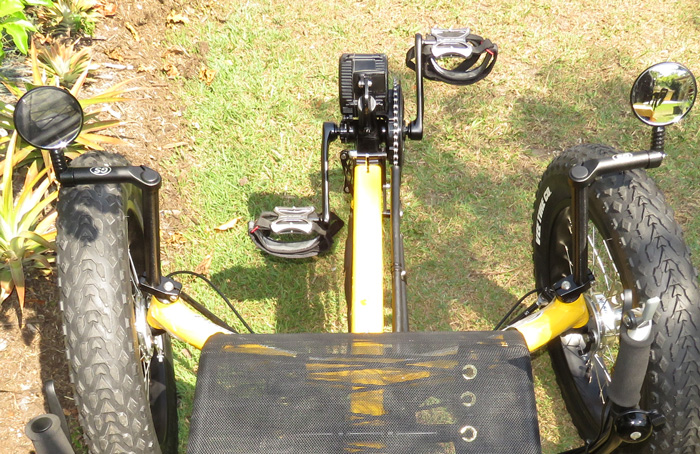It is not uncommon for people to want to include Electric Assist (a motor) when considering a bike or recumbent trike.
Mid Drive or (Direct Drive) Hub Motor: is one right and the other wrong? I don’t think so.
Electric Assist Considerations
For the un-initiated in the pedal power world, both bikes and trikes can consume finances to a rate which at times feels like it’s leaning a little towards the concept of a boat (a whole in the water you throw money into). Well, maybe not so bad but it can certainly be a bit more than you’d perhaps expect after shopping at BigW for a pushbike for the child’s birthday ($100 – $150).
When you start talking push bike parts, even for the two wheel cousin, you can start to spend many thousands of dollars. You could look at the end of the spending process without being able to see much if anything for your efforts. Part of the reason is the design of parts for such items has not so far been on a really large scale (mass produced in the true form). Similarly for items such as Internal Geared Hubs (IGH) where the effort is to make them strong but small and light in an effort not to add more rider effort than need be.
Generally when parts are designed, they take into account that a push bike will be ridden by a very fit person perhaps producing 250 watts of energy to motivate the bike into motion. So far there has not been much thought in bike or trike design, that an 8kg robot (the motor) who can produce 1,500 watts of energy would be doing the riding. This can cause excessive wear and even damage to items designed only to take 250 watts of energy.
I know I’m at the bottom end of the muscle power application ladder and I’d only likely apply that very fit person’s 250 watts to the pedals for a minuscule amount of time. Minuscule as in if I happen to be pedalling forward and happen to sneeze at the same time… Any other great bursts of energy would be in fright of being run over by a truck or bus. In reality I’m probably a 100 – 150 watt kind of person so adding a 250 watt motor is quite pleasing on the hill or if I happen to get too far away from home and I tucker out. Of course the more power you produce at the motor, the more battery you need to run it. My physical condition dictates I have the backup power to be able to get home, should I have done a little too much or got too far. Electric assist for me is therefore pretty important. We have seen quite a number of trikes go out to others that have had a similar situation and I see no problem with the desire to add a couple of hundred watts that can be applied by other than the rider should the need arise. Better to be out doing some pedalling that at home doing none.
Some other people just like the thrill of being able to keep up with the more athletic without the need to be burning so much winter store (fat). In any case, electric assist motors are popular, when you go make your purchase, please have already considered what your needs will be. You can consider things like power requirements before you even look at a recumbent trike and for some it is the first consideration.
During the years I have seen a number of different hub and Bottom Bracket [B/B – where the pedals connect] mounted motors on recumbent trikes. My own trike started life with a hub motor with lots of battery storage. We also have in the family garage, the forward mounted (mid drive or B/B) motors. Each has advantages and disadvantages so ask questions about your own situation.
On a standard shape push bike (bicycle), the pedals are about mid way along the bike and with the introduction of this type of motor they were called mid drive to match the position of the pedal bracket (bottom bracket). On a trike this motor type is positioned at the front of the trike as this is where the pedals are mounted.


Australian laws
…in general require that an electric assist bicycle or tricycle (trike for the sake of this topic) operate at a throttle power of not more than 200 watt output. This means if you have a twist grip throttle, like a motorbike, or any other type of manual throttle such as a thumb lever, the largest motor you can use is 200-watt.
The exception
…to this rule is if the motor of the trike can only be operated by the rider pedalling the trike and the motor cuts out when the rider stops pedalling [pedelec], then the motor can be rated up to 250 watt maximum power. Every watt at this lower level that you can gain is worth while as by the time you add a motor and battery system you are adding a number of kilograms to the ride and all hills seem steep.
Many people have said to me although they have motors that may be branded as 500 or 700 watt (and more), they have tweaked the settings so that it is maxed out at 250 watt and therefore legal on Australian roads. I fear this is misleading and the results could include fines for driving an unregistered vehicle, driving without a motor cycle helmet and alike. A trike with a motor more than 200-watts and has a manual throttle or a motor larger than 250=watt pedelec needs to be registered to use on public roads.
While it is good to have a mid mount motor to take advantage of the gearing system, a high wattage motor can overload the drive chain system. Remembering that the average Joe, isn’t going to create a lot of power, if you put yourself on the trike and then add a 1,000 watts, you are no longer an average Joe (or Joanne). Suddenly you’re a SUPER JOE (or SUPER JOANNE) and you can almost climb Mt Kilimanjaro on a single charge.
We have met a chap recently who has added to this topic by telling us of his long and intense efforts to try and over come some of the problems related to high power mid drive motors. Chain and sprocket wear and it is still a work in progress and now seems one that cannot be won. Past customers who have later added reasonably high powered mid mount assist motors have reported similar and additional problems. These relate to the drive system and weight balance of having those few extra kilos hanging out over the front and high twisting (torque) energy. I spend quite a bit of effort to get rid of the kilos hanging over the front (belly) so I can well sympathise with the recumbent in the same situation.
Worth Considering
My own trike had what is called a hub motor (at the rear) and has given many years of excellent service. The hub motor is called this as the actual hub of the wheel has the motor built into it. On mine it is the single rear wheel, it could be the two front wheels or even all three (mountain goat) or it could be just the front wheel on a delta trike.
For me the hub motor was appropriate for power and no load on the drive chain. A Mid Mount Motor would be more appropriate in a situation where a motor needs to be more “high and dry” and or a maximum of 250-watt pedelec to be able to take advantage of gearing:

The hub motors (we use) do not (generally) have an internal geared system so it limits the ability to have an economically priced large gear range. Hub drive can not take advantage of the gearing system to create extra torque to climb the rocky crags. It does however have no affect on the rest of the drive system as it takes the load off the pedal system and while making it easier for me also makes it easier for the chain and sprockets. I can’t tow a 20 hundred weight (really heavy) trailer up a hill but I am more than happy that it can get me up a hill and home.
I would suggest that the Australian legal power restrictions for a bike/trike are a good place to start. There are situations where a mid mount motor is good. There are situations where a hub drive will serve you and your trike better. If you add a motor to a trike with a Continuously Variable-speed Transmission, remember there are manufacturer limitations on gear ratios and power (wattage) application [i.e.: you may void your warranty].
If you have fitted a Mid Drive motor and need more gears you can consider a Rohloff Internal Geared hub. In either case, don’t be surprised if you add another $2,000 or more to the cost of the bike/trike.
Fore-something is good …whats the word – oh yes, fore-thought, it could save you a lot of fiddling, money and heartache. One returning customer whom originally fitted a high power B/B motor, tried a trike with a 250-watt motor and said he wished he’d have stayed at that level which in the end provided all the power he’d need. Have a think then get out there and have fun.
Batteries: Look here
Shimano E8000 and E6100 units: Look here